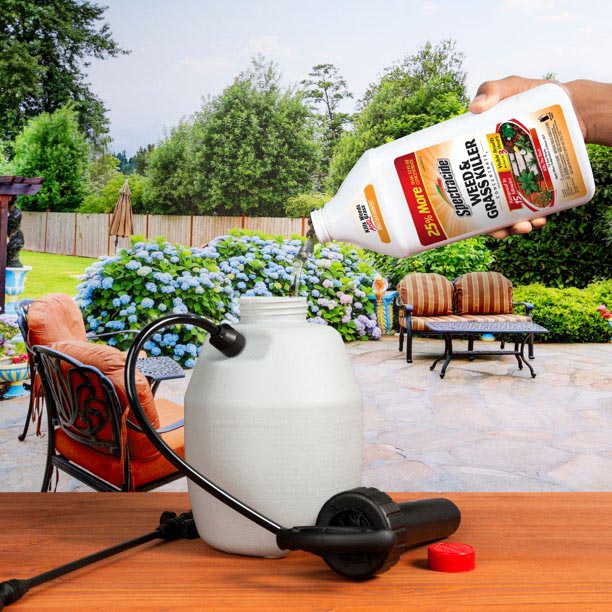
If you want your weed killer to work right, then you have to apply it at the right time. When is the best time to apply weed killer? We’ll tell you below.

When Is the Best Time to Apply Weed Killer?
Overall the best time of the year to apply weed killer is in the Spring. The best time of the day to apply weed killer is late morning to early evening. Apply pre-emergence weed killer in early spring. Apply post-emergence weed killer as soon as you see new weeds, or if the weeds are fully grown cut them off, wait for new leaves to grow and then apply.
What to Know About Weed Killer
Herbicides are important products to keep your garden healthy and beautiful.
Weeds may be plants, but they are unwanted plants. These unwanted plants would steal nutrients from plants in the garden.
And if nourished, they may eventually take up the entire space of the garden.
In essence
Weeds have to be removed so that your plants will have all the nutrients intended for them. The same with sunlight and water, if there are weeds around, they too would compete to have them.
That’s why weed killers are important.
Basically
Herbicides or weed killers are substances that you apply on weeds to control them and eventually kill them.
There are two basic types:
- Selective herbicides
- Non-selective herbicides
The names are self-explanatory. Selective herbicides kill specific types of weeds while the other kind basically kills all weeds.
Further
There are also weed killers that are organic and non-organic. The former is better for the environment and is usually not harmful to other plants.
The latter uses strong chemicals to really work. It’s stronger but it may also harm peripheral or nearby plants.
Also
Weed killers may be distinguished based on how they function. There are weed killers that are applied on the roots while others are applied on the foliage.
They can also be identified through timing of application:
- Pre-plant
- Pre-emergence
- Post-emergence
For the pre-plant herbicides, you apply them to the soil before you even start planting your plants. The pre-emergence ones are applied before weed seedlings start appearing. Once weeds are clearly visible, then you need to kill them with a post-emergence weed killer.
Here are some of the most common types of organic herbicides:
- Corn gluten meal
- D-limonene
- Flame
- Saltwater
- Steam
- Vinegar
Here are the more popular chemical herbicides:
- 2, 4-D
- Aminopyralid
- Atrazine
- Clopyralid
- Dicamba
- Fluazifop
- Fluroxypyr
- Glufosinate ammonium
- Glyphosate
- Imazamox
- Imazapic
- Imazapyr
- Linuron
- MCPA
- Metolachlor
- Paraquat
- Pendimethalin
- Picloram
- Sodium chlorate
- Triclopyr

Things to Know Before Herbicide Application
Weeds are going to be a major problem in the garden. They could invade it and render your plants malnourished.
Eventually, the plants will die.
So
Instead of waiting for that to happen, you should kill the weeds first.
When they start emerging, you can just pull them out. Make sure you pull out all the roots so they won’t continue to grow.
But if the weeds become too much, you won’t be able to keep up with killing them.
That’s why
You have to resort to using herbicides or weed killers.
Here are important things to know before using the herbicides:
1. Start with prevention
You want to make your garden as healthy as possible. When you do that, the entire garden will not be vulnerable to weeds.
This doesn’t mean that weeds will not start sprouting, but it’s just a good form of prevention.
Here’s the deal
Healthy garden will not give weeds a chance to take over. It would also be a good idea to blanket the soil with a healthy lawn.
To ensure a healthy garden, you need to grow plants that are native of the area. Native plants mean that they would thrive in the region’s climate and the average soil type.
Be smart!
That’s right! You have to be smart and practical with your choices.
As soon as you see a single weed, you have to pull it out immediately. Don’t wait for the weed population to multiply.
2. Identify the weeds
When the weeds have multiplied and you now have to use herbicides to control growth, it would be very helpful if you can identify the type of weeds growing in your garden.
This way, you can find the right weed killer for the specific pesky plant that you have.
3. Read the herbicide instructions properly
Most weed killers are made of harsh chemicals. They have to be handled with care.
4. Timing is everything
While there isn’t necessarily a wrong time to put herbicides, there is a right time to use it.
The right time will mean success in killing all the weeds while not affecting the nearby plants. The appropriate time will also mean safety during application.
So, when is the best time to apply weed killer?

Best Time to Apply Weed Killer
Weeds are bad news, we have to get rid of them. We already know that herbicides will be necessary for the overall health of the garden.
Now, it’s just a matter of figuring out the right time to apply a weed killer.
And there is a right time!
There’s also the right time for a particular weed killer. So, it’s also important to differentiate:
Pre-emergence weed killer
This type of herbicide is usually used for established lawns. You want to make sure that weeds don’t just come up somewhere.
You want to make sure that you apply this before the weeds have sprouted. The best time to do that is early spring.
Then
You need to reapply eight weeks later especially if you have to deal with really invasive weed species.
Post-emergence weed killer
This is obviously applied when you already see the weeds. The best time to apply this type of herbicide is the moment you see them.
It is best to apply the weed killer when the weeds are still very young.
In fact
If the weeds are already fully grown, it would be better if you just cut them off and wait until new leaves start to grow.
Then you apply post-emergence herbicide.
Overall
The best time of the year to apply weed killer is SPRING. Whether it’s early spring or late spring. The weather is warm and you don’t expect frost.
You might think, why not summer? It’s hot. Precisely because it’s really hot that’s why it’s not advisable.
The spray could immediately evaporate under the heat of the sun.
Importance of weather timing
Let’s say that it’s early spring and you want to apply a pre-emergence weed killer. You can’t just do it at any time as long as it’s early spring.
You have to consider the weather.

What to consider:
You should wait until you’ve experienced several days of really dry weather before you start applying your herbicides.
The problem with rainwater is that it could wash off the herbicides. Then, it won’t work as efficiently as it should in killing weeds.
You don’t want that
Rainwater could dilute the efficacy of your herbicides. Then, it will no longer be practical.
Another thing:
You also want to reference the wind. Check out your local weather forecast. There are several reasons why you don’t want to apply herbicides during a windy day.
For one, it’s not safe. You don’t want particles touching your skin because there was a gust of wind while you were spraying the weed killer.
Look
You have to be safe when you spray your herbicide, whether it’s windy out or not. You should have gloves on, goggles, and even a face mask.
However, when it’s windy, some of the aerosols could touch other parts of your body.
That’s not good!
So, always be purposeful with your herbicide application schedule.
This is also a practical concern for the other plants of the garden. When it’s windy, some of the spray might reach your healthy plants.
There’s a name for it
It’s called a herbicide drift. This is the process wherein herbicide will reach your other plants because of the wind.
Weed killers could kill regular plants. After all, weeds are just plants that are not wanted.
Operational timeline
Some weed killers complete the work in a few days. Some would take a week, while others take longer.
Read the instructions properly so you can prepare an appropriate schedule.
Schedule accordingly
You have to take into consideration your planting schedule when you apply weed killers while taking into consideration the right time and weather.
What time of the day should you apply herbicide?
The best time to apply weed killer during the day is from late morning to early afternoon. This is because the early morning maybe dewy and dusk to evening won’t have the right temperature.
Ideally, daytime temperature should be around 80℉ or 27℃ when you spray herbicides.

Summary
If you want the herbicide to do its work efficiently, timing will be important. There is a best time to apply a weed killer–an appropriate season for it and the right time of the day to do it.
The best time to apply herbicide is when it’s not raining and there is no frost. You want the weed killer to penetrate the weeds with no rain to wash it off. But you also don’t want to do it when it’s too hot since the spray might evaporate immediately.
The same things should be on your mind when choosing the right time of the day to apply the substance. Late morning to early afternoon would be ideal.
Useful Resources
- When and How to Use Herbicides – Gardening Know How
- 8 Best Weed Killers of 2021 – Good Housekeeping
- Weed Killers: 5 Things to Know Before You Spray – Better Homes & Gardens

